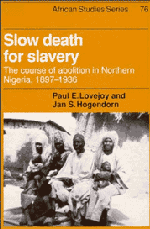Book contents
- Frontmatter
- Contents
- List of maps
- List of tables
- Preface
- 1 Slavery and the British conquest of Northern Nigeria
- 2 Fugitive slaves and the crisis in slavery policy
- 3 The debate on legal-status abolition
- 4 Emancipation and the law
- 5 Upholding proprietary rights to land
- 6 The role of taxation in the reform of slavery
- 7 The colonial economy and the slaves
- 8 The persistence of concubinage
- 9 Legal-status abolition: the final phase
- Appendix: Court records of slaves issued certificates of freedom
- Notes
- Glossary
- Bibliography
- Index
- Title in the series
3 - The debate on legal-status abolition
Published online by Cambridge University Press: 03 May 2011
- Frontmatter
- Contents
- List of maps
- List of tables
- Preface
- 1 Slavery and the British conquest of Northern Nigeria
- 2 Fugitive slaves and the crisis in slavery policy
- 3 The debate on legal-status abolition
- 4 Emancipation and the law
- 5 Upholding proprietary rights to land
- 6 The role of taxation in the reform of slavery
- 7 The colonial economy and the slaves
- 8 The persistence of concubinage
- 9 Legal-status abolition: the final phase
- Appendix: Court records of slaves issued certificates of freedom
- Notes
- Glossary
- Bibliography
- Index
- Title in the series
Summary
Although George Goldie was responsible for the decree that abolished the legal status of slavery in 1897, the real architect of slavery policy in Northern Nigeria was Frederick Lugard, who was first on the scene in the Sokoto Caliphate in the famous march on Borgu in 1894 to forestall French expansion and thereafter was a confidant of Goldie. The choice of Lugard to head the West African Frontier Force in 1897 kept him firmly in the picture, and when he became High Commissioner of the Protectorate of Northern Nigeria in 1900, he was able to implement his ideas. Six years later, when he was transferred away from Northern Nigeria to become Governor of Hong Kong, he could claim to have set in motion an irreversible transition in the slave economy and the condition of slaves in Northern Nigeria.
Lugard had written extensively on legal-status abolition throughout the 1890s. His views, which were widely read, reflected the influence of informed public opinion on this issue, and he owed a special debt to Sir John Kirk, whom Lugard considered to be the “foremost authority on slavery” and who was the official responsible for applying the strategy of abolishing the legal status of slavery to the domains of Zanzibar, also in 1897. Lugard thereby identified with a policy that stretched back over a half-century to India, Burma, Ceylon, and Hong Kong.
- Type
- Chapter
- Information
- Slow Death for SlaveryThe Course of Abolition in Northern Nigeria 1897–1936, pp. 64 - 97Publisher: Cambridge University PressPrint publication year: 1993
- 1
- Cited by



